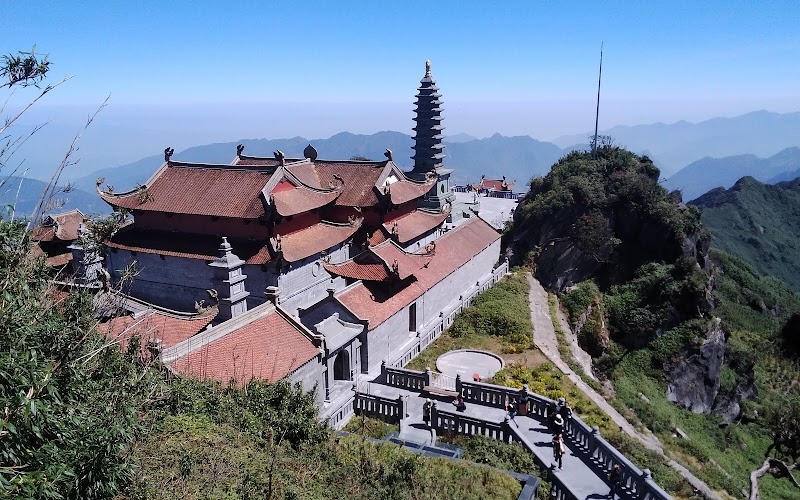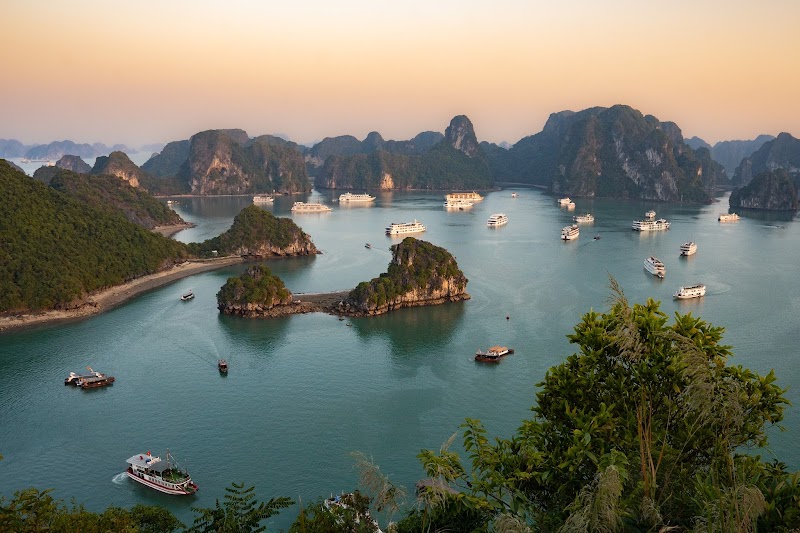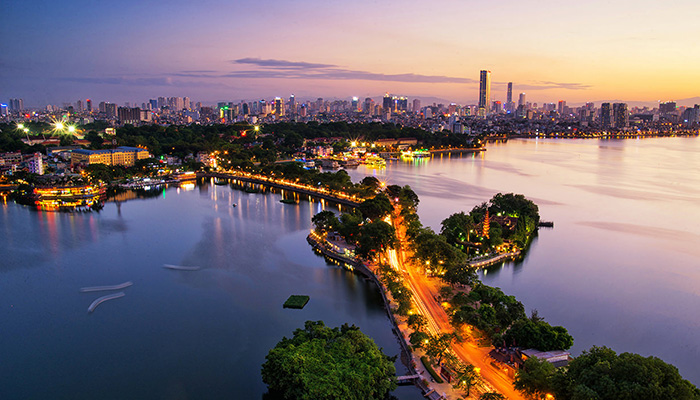Welcome to the North of Vietnam
Immerse yourself in the timeless allure of the North of Vietnam, a region that's a convergence of over 1,000 years of vibrant history, rich cultural heritage, and breathtaking landscapes. From the awe-inspiring terraced fields in Sapa to the surreal beauty of Halong Bay and the bustling Old Quarter of Hanoi, every corner of Northern Vietnam unfolds an enchanting tale.
To navigate these labyrinthine treasures of experiences, a tourist map is your best companion. Armed with a tourist map, you can weave your way through the region, discovering the diversity and proximity of its key attractions at your own pace, and in your own style.
Booking.comUnveiling the Wonders of the North of Vietnam
Embarking on an adventure in the North of Vietnam unfolds a mesmerizing journey imprinted with rich culture, history, and awe-inspiring landscapes. Let's delve deeper into the captivating attractions in this part of Vietnam.
Immersive Cultural Experiences
Hanoi's Temple of Literature
Take a step back in time with a visit to the Temple of Literature in Hanoi, a mark of Vietnam's deep-seated respect for education and literature. Established in 1070, this Confucian temple also functioned as the country's first national university. Its tranquility juxtaposed with the bustling city outside presents a unique blend of sacredness and scholarly ambiance.
Hoan Kiem Lake and Ngoc Son Temple
Situated in the heart of Hanoi is the idyllic Hoan Kiem Lake, a tranquil oasis amid the vibrant cityscape. Nestled on a small island in the lake is the Ngoc Son Temple, a sacred site steeped in history and legends. Its picturesque beauty and cultural significance make it an ideal starting point to comprehend the spirit of Hanoi.
Exploring Breathtaking Landscapes
Ba Be National Park
For nature aficionados, the Ba Be National Park is an untouched paradise brimming with lush forests, sparkling lakes, and towering limestone cliffs. A boat trip down the Nang River unravels a diverse range of wildlife and the Dau Dang waterfall, a spectacle of nature's raw power. This park is a haven of biodiversity and an exceptional spot for trekking and bird watching.
Ban Gioc Waterfall
Feast your eyes on the magnificent Ban Gioc Waterfall, one of the largest and most beautiful waterfalls in Southeast Asia. Its water cascades down various layers of limestone, creating a hypnotic scene that soothes the senses. Located near the China-Vietnam border, this waterfall is a hidden gem worth exploring.
Taste of Tradition and Modernity
Old Quarter, Hanoi
Get lost in the narrow streets of the Old Quarter in Hanoi, a bustling neighborhood that encapsulates the blend of the old and the new. Centuries-old architecture coexists with modern establishments, each narrating their own tales. Explore the myriad of shops, cafes, and street food stalls, each offering a taste of Hanoi's dynamic culture.
Contemporary Art Scene
The North of Vietnam is also a thriving hub for contemporary arts. Artists' studios, galleries, and art spaces in Hanoi are pulsating with creativity and innovation, reflecting the country's shifting cultural landscape. Visit the Vietnam Fine Arts Museum and the Factory Contemporary Arts Centre to immerse yourself in this vibrant art scene.
Plan your journey with a detailed tourist map of Vietnam, discover the heart of Hanoi and explore the rich diversity of central Vietnam. Every corner of this region reveals a unique story waiting to be discovered.

Practical Information for Visiting the North of Vietnam
Transportation and Mobility
The main modes of transport in the North of Vietnam are buses, taxis, motorbikes, and bicycles. You can rent a motorbike or bicycle in most cities, which is an excellent way to explore at your own pace. Taxis are also quite affordable and reliable, especially if you stick with trusted companies like Mai Linh or Vinasun.
For longer journeys, such as traveling from Hanoi to Sapa or Halong Bay, overnight sleeper buses and trains are the most popular options. Booking tickets in advance is recommended, especially during peak travel seasons.
Schedules and Prices
The standard operating hours for most attractions in the North of Vietnam are from 8:00 AM to 5:00 PM. Some places, like the Temple of Literature in Hanoi, may close for lunch between 11:30 AM and 1:30 PM. It's always best to check the specific opening hours before planning your visit.
Entry fees can vary greatly depending on the attraction. For example, a ticket to the Hoan Kiem Lake and Ngoc Son Temple costs around VND 30,000 ($1.30), while a two-day cruise in Halong Bay can cost anywhere from VND 3,000,000 to VND 6,000,000 ($130 to $260).
Safety Tips
While the North of Vietnam is generally safe for tourists, it's crucial to take common-sense precautions to ensure a smooth trip. Be mindful of your belongings in crowded areas, and avoid isolated places at night. When renting motorbikes or bicycles, always wear a helmet and follow the local traffic rules.
It's also important to be aware of the local weather conditions when planning your trip. The North of Vietnam experiences heavy rainfall during the monsoon season (May to September), which could affect outdoor activities and travel plans.
Practical Recommendations
When visiting the North of Vietnam, consider avoiding the peak tourist season (July and August) if possible. This allows you to enjoy the attractions without the crowds and also get better deals on accommodation and tours.
It's also recommended to carry cash, as not all establishments in the North of Vietnam accept credit cards. ATMs are widely available in cities, but can be scarce in smaller towns and rural areas.

Frequently Asked Questions
1. What special experiences can I enjoy in North Vietnam that are unique to the region?
North Vietnam offers a plethora of unique experiences. From enjoying a serene boat ride in the Trang An Grottoes to experiencing the bustling local life at Bac Ha Market, there's always something special to discover. Don't miss out on a visit to the ancient capital of Hoa Lu, which offers an intriguing glimpse into Vietnam's rich history. Also, for an immersive cultural experience, spend a night in a traditional stilt house with a local family in Mai Chau Valley.
2. Are there any special food experiences that I shouldn’t miss in North Vietnam?
North Vietnam's culinary scene is vibrant and diverse, offering a unique taste of the country's culture. In Hanoi, make sure to try the city's signature dish, Pho, a traditional noodle soup. Street food tours in Hanoi's Old Quarter are a must for food lovers. For a more unique experience, visit the rural areas to sample local specialties like Com Lam, a bamboo-cooked rice dish, and Ruou Can, a traditional rice wine.
3. Can I take part in local festivals in North Vietnam?
Yes, participating in local festivals is a fantastic way to immerse yourself in the local culture. The Lunar New Year (Tet) is Vietnam's biggest festival, teeming with traditional games, food, and customs. The Mid-Autumn Festival is another significant event, especially in Hanoi, marked by colorful lanterns, mooncakes, and lively street performances.
4. What is the best way to travel between cities in North Vietnam?
While buses are the most common method of intercity travel, trains offer a more comfortable and scenic way to explore the North of Vietnam. The Reunification Express train, for example, offers a picturesque journey from Hanoi to Sapa. For shorter distances, motorbike rentals are a popular choice, giving you the freedom to explore at your own pace.
5. What precautions should I take regarding wildlife in North Vietnam’s national parks?
When visiting national parks in North Vietnam, it's important to respect the wildlife and adhere to the park's rules and guidelines. Avoid feeding or disturbing the animals, and maintain a safe distance. It's also advisable to hire a local guide who can assist in navigating the terrain and provide information about the local flora and fauna.
6. Are there any unique shopping experiences in North Vietnam?
Indeed, North Vietnam offers unique shopping experiences that go beyond traditional souvenirs. In Hanoi's Old Quarter, each street traditionally specializes in a specific trade, from silk tailoring to silver jewelry. For authentic handicrafts, visit the ethnic markets in Sapa, where you can find hand-woven textiles and intricate silver jewelry crafted by local tribes.

